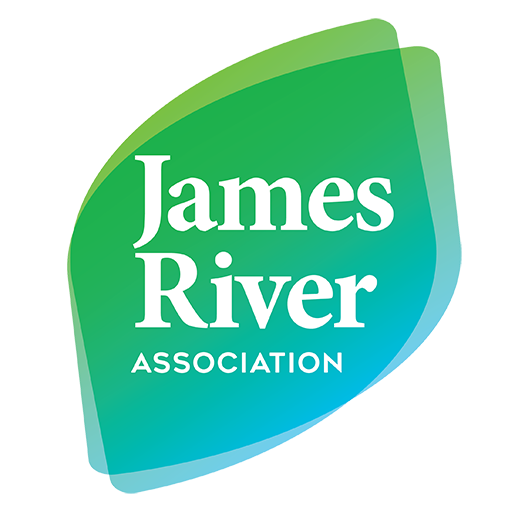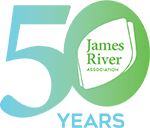PRESS RELEASE
FOR IMMEDIATE RELEASE
June 26, 2024
MEDIA CONTACT:
Jamie Brunkow, Director of River Ecology
James River Association
jbrunkow@thejamesriver.org | 804.592.0347
Partnership makes waves with innovative approach to stopping shoreline erosion
Nature-based living shoreline protects historic agricultural property and yields benefits for James River
Charles City, VA – James River Association is announcing the completion of the Berkeley Plantation Living Shoreline project, designed to combat erosion and enhance coastal resilience. In addition to safeguarding over 1,500 feet of shoreline along a working agricultural landscape, the project will improve water quality in the James River by removing pollutants while providing habitat for wildlife.
A ribbon-cutting ceremony on June 27 will celebrate the culmination of the project and nearly three years of collaborative efforts between the James River Association (JRA), the Colonial Soil and Water Conservation District (Colonial SWCD), the Virginia Department of Conservation and Recreation’s Shoreline Erosion Advisory Service (DCR-SEAS), and the Virginia Department of Environmental Quality (DEQ).
This partnership was instrumental in pioneering an approach to fund the $895,000 living shoreline project. The design and installation were supported by funding from the Virginia Agricultural Best Management Practice Cost-Share (VACS) program administered by the Virginia Department of Conservation and Recreation, alongside a grant from the National Fish and Wildlife Foundation’s Innovative Nutrient and Sediment Reduction program, as funded by the U.S. Environmental Protection Agency and Altria Group. The Virginia Department of Environmental Quality’s Agricultural Best Management Practice Loan Program provided a zero-interest loan to the property owner for construction.
“We’re thrilled to have forged this partnership,” remarked Jim Wallace, Manager of the Colonial Soil and Water Conservation District. “Bringing state and non-profit partners together with the District in support of the project allowed us to leverage our collective expertise and financial tools, resulting in a successful and innovative conservation project.”
Living shorelines use natural materials and native plants to create a more resilient and ecologically beneficial defense against erosion. The Berkeley Plantation Living Shoreline design features strategic use of stone breakwaters and sills, sand nourishment, and plantings of marsh species like saltmeadow hay and big cordgrass. These nature-based features help to create a dynamic shoreline that can better adapt to the risks of sea level rise, when compared to traditional means of shoreline protection like bulkheads.
“The Berkeley project is a testament to the effectiveness of living shorelines in promoting coastal resilience,” said Jamie Brunkow, Director of River Ecology at James River Association. “In addition to protecting shorelines, these projects conserve and restore natural habitats, trap pollution and improve water quality.”
By creating tidal wetlands that absorb nutrients and prevent over 105 tons of sediment from eroding into the James River annually, the project significantly contributes to restoration goals for the James River and Chesapeake Bay. Living shorelines are Virginia’s default regulatory approach to protection of eroding tidal shorelines, but examples of large projects such as Berkeley are still rare on agricultural properties due to the cost and complexity for property owners. As the first-ever living shoreline funded by the Virginia Agricultural Best Management Practice Cost-Share (VACS) program, the Berkeley project represents a significant milestone in tidal shoreline conservation and an example for partners to scale up future efforts.
“Living shorelines are critical to restoring the Chesapeake Bay, while at the same time protecting coastal farms from erosion. DCR is grateful for continued record levels of funding for the Virginia Agricultural BMP Cost-Share Program,” stated James Martin, Director of the Soil and Water Conservation Division at the Virginia Department of Conservation and Recreation. “This investment by the General Assembly and Governor allows DCR to expand our work with local soil and water conservation districts to deliver conservation practices to more agricultural producers across Virginia.”
The Berkeley Plantation Living Shoreline ribbon-cutting will be followed by guided tours led by representatives from the James River Association and the Colonial Soil and Water Conservation District. The event will showcase the project’s innovative approach and recognize the contributions of all partners involved.
Event Details: Berkeley Plantation, 12602 Harrison Landing Rd, Charles City, VA 23030
Thursday, June 27, 2024, 11:00 AM – 12:00 PM
Members of the press are invited to join this event to learn more about the Berkeley Plantation Living Shoreline project and its impact. For more information about the event please contact Jamie Brunkow at jbrunkow@thejamesriver.org.

ABOUT JAMES RIVER ASSOCIATION: The James River Association is a member-supported nonprofit organization founded in 1976 to serve as a guardian and voice for the James River. Throughout the James River’s 10,000 square mile watershed, the James River Association works toward its vision of a fully healthy James River supporting thriving communities. The James River Association believes that “when you change the James, the James changes you”. With offices in Lynchburg, Richmond, Williamsburg, and Scottsville, the James River Association is committed to protecting the James River and connecting people to it. For more information visit www.thejamesriver.org.
